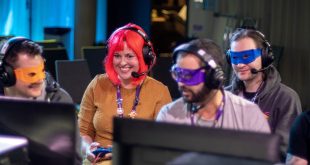Late last month I had something of an unusual experience. Now bear with me, because this is going to sound pretty out there: But I was actually outside of my flat. In a North London bar. Talking to people who work in the games industry. We really should come up with a name for that sort of thing.
As the media partners of Ukie’s UK Game of the Show and Europlay (think Eurovision but for unreleased video games), I had the honour of judging a wide array of incredible-looking upcoming titles – from a bear who runs a B&B in the woods to a suspiciously sexy Poirot.
But ultimately there could only be one winner – And the UK’s very own Robot Turtle went home the victor of Europlay 2021.
Viewfinder is a unique puzzle game built around a truly fascinating mechanic, one that really is best seen in action. Which I admit is a little difficult for a print publication, but I’ll do my best.
The player interacts with the game’s world via a polaroid camera. Take a picture, and then hold that picture up in front of you, and its contents become a part of the world. For a basic example, you could hold up a photograph of a bridge, and lo and behold said bridge will appear before you, opening up a new path.
In practice however, things can get a lot more complicated. The game has boundless potential for creativity and experimentation, so we’re certain to see people’s problem-solving all over social media once the game is finally out.
It’s all a lot to take in, and certainly a lot to get excited about. Which is why we wasted no time in sitting down with Matt Stark, game director at Robot Turtle, and former Lionhead developer Georg Backer to find out more.

MAKING AN INCEPTION
While the pair were delighted and surprised to have won, spending much of our time together passionately discussing which of the competition’s games had interested them the most, they nonetheless shared the excitement we felt about getting our hands on Viewfinder.
“I think that one thing that is really cool about it,” says Stark, “is that when people see it, they want to get their hands on it. They want to try things with it. It’s not just that they want to see it being played, they really want to see what they can do with it, and what it will let them do.
“You can get really creative with it. You can make really cool screenshots where you take a chunk of the world and you repeat it like 10 times, and it’s upside down and twisted in different angles and stuff. You can suddenly get some very Inception-like screenshots. So it’ll be really cool to see what people come up with.”
The team are tight-lipped about when the rest of us can play the game, but Backer is keen to share his experiences on an early prototype of Viewfinder.
“What I love about it is that sure, you have the simple setup of the picture mechanic – hold up a photo, and that picture becomes reality,” says Backer. “But once you grasp that, you start to realise the implications of it, there’s this domino effect where you just think ‘holy shit!’
“I still remember to this day when Matt sent me the original prototype. I’d seen the stuff he’d already posted on Twitter, and thought it looked interesting. I loaded up the prototype and played it through – I didn’t stop. It was two hours later, and it was one of the first things I’ve opened and immediately played through to the end. As busy people, you don’t take that luxury very often. That was when I realised that holy shit, this is a very cool idea.”
Of course, the game needs to be more than just a cool idea. Eye-catching mechanics are all well and good, but you need more than that to carry a full-length experience.
“When I was first showing off the game,” says Stark, “a lot of people’s questions were: ‘Can it be a full game? Can it be more than just like a short tech demo?’ So the question that I was really trying to answer with the first prototype was just, does it have that longevity? Can you have a wide variety of puzzles and stuff with it?
“Once I got to that point where I proved to myself that it could be a full game, that’s when things really started to take off. With mechanics like this, part of the challenge is figuring things out. What does it look like as a game? What would the actual challenge be? I mean, there’s so many directions it could go in.”

PICTURE PERFECT
While Robot Turtle eventually settled on a more slow-paced, enjoyable puzzle experience, knowing what to do with a mechanic and actually implementing it are two very different things. And the potential headaches of introducing magical photographs you can rotate and step inside of are… numerous, to say the least. Has the team struggled with this?
“Yes!” Stark laughs. “Every mechanic in the game has to be fully compatible with the picture mechanic. What that means is that, you need to be able to flip it on its head, you need to be able to cut it up in any way, you need to be able to erase it from the world… Yeah, there’s so many weird situations there.
“And in addition to that, a video we released recently shows us rewinding time in it. So that means that every bit of every element both has to work with a picture mechanic, and has to be able to work both backwards and forwards through time. So yeah, it can be a tricky thing to get working.
“And to make it even worse, everything needs to be able to apply visual effects to things. So in the previous video, there’s a bit where you pull up an oil painting, and there’s kind of some effects on it that makes everything look a bit more oil paintingy, and stuff like that needs to be applied. There’s also pictures that turn everything grayscale, and that has to be able to be applied to everything.
“So yeah, there’s a lot of moving parts. There’s definitely challenges there. But on the flip side, it’s also a really interesting project to work on because it has these really interesting programming and design challenges.”
Even games as unique and interesting as Viewfinder pull inspiration from somewhere. Many people’s initial response to a first person puzzle game with a unique central mechanic is to point to Portal. And while there are certainly some similarities there, the team is more inspired by the cohesiveness of Portal, rather than any singular mechanic.
“Without giving too much away,” says Backer, “We’re very aware that, with a game like this where you’ve got a unique mechanic, there’s always the danger of being able to veer into gimmicky territory very easily. What’s really cool is that everyone that’s involved in it is very, very aware that this can happen. So we are making a huge conscious effort to make sure that this game is what it wants to be, not what we want it to be.”
“Yeah, we’ve been figuring out how to get it so it doesn’t just feel like we kind of tacked a bunch of stuff on to try and pad it out,” adds Stark, “we want to make it feel like a cohesive whole. And that’s one thing that Portal does incredibly well. Every single bit of Portal is in service to the main mechanic in some way.”
“That’s the thing,” Backer agrees, “We don’t want this to be a few gimmicky levels. The game wants to be a coherent journey that you go through as a player. You have fun with the mechanics, but you’re also taken on a journey. We’re very serious about the narrative approach, we’re very serious about making sure that it’s all in service of the game. And those are often some of the biggest conversations.
“The type of games where everything feels like it came from one cloth, that’s what’s important to us. That’s what we had in mind when we were putting the team together, we were looking for people with that kind of sensibility. It’s not just about designing a puzzle, it’s about designing a world in which this puzzle can exist, where it’s coherent and makes sense.
“That’s the hardest thing to do, puzzles and narratives are the hardest combination. You take something that is systematic like this mechanic, and then build in a narrative that hopefully takes the player on a journey… it’s stupid hard.”
“Yeah, it can be quite hard to contextualise,” agrees Stark. “I mean, if you’ve got a fighting game, it’s not that hard to contextualise – you just have to tell a story where there’s conflict, but a puzzle game is a lot more challenging.”

THINKING WITH PORTALS
Robot Turtle’s desire for a cohesive puzzle game isn’t the only place where Portal’s influence can be found. From Half Life 2’s Gravity Gun to the Portal Gun, Valve are in many ways the experts in making unusual new mechanics quickly feel natural to the player, something that Viewfinder would do well to emulate.
“A big part of Portal is you actually learning the mechanic, getting your head around it and finding different ways in which you can use it to your advantage,” says Stark. “It’s like the whole game is almost like a tutorial in that sense.
“And I think that Viewfinder both will and should be kind of like that, because it is quite a difficult mechanic to get your head around, it is something that you need to gradually learn. What we tend to find is, if we give the player the camera right from the beginning, it can be quite overwhelming. We’re gonna have to manage that quite carefully, and gradually onboard the player into the mechanic.”
Once onboarded though, there’s plenty of room for experimenting in Viewfinder. Stark himself admits that players will almost certainly come up with creative solutions to puzzles that he’d never thought of, given the variety in ways the game’s central mechanic can be utilised.
“Every time I see someone testing any of my levels, it’s almost certain that they’ll come up with at least one better solution that I hadn’t thought of or seen before.”
And that potential for emergent gameplay really opens Viewfinder up to a lucrative market: that of influencers and speedrunners.
“I think it will be really good for speedrunners,” notes Stark. “Because there’s a lot of flexibility in terms of how you approach situations. But also more generally, I think it’s a game that people will have fun watching being played, because of how creative you can be in solving things. There’s often more than one solution to any puzzle, there doesn’t necessarily need to be a single, correct solution.”
Of course, the problem with emergent gameplay is making sure that players won’t accidentally break the game…
“I think this is the one where we will probably cry a lot during QA,” Backer predicts. “I think I might leave the project before QA starts, is that okay?”
QA issues aside, this is very clearly a passion project – for Stark in particular, having dropped out of university to work on Viewfinder. And with the pair revealing that they have a VR prototype in the works, it’s one that’s shaping up nicely.
“Whenever Matt presents Viewfinder to us,” reveals Backer, “it’s like he’s this kid who’s so excited to show you what he’s done. Every week is just another instance of ‘holy shit, how do you come up with this stuff?’ I’ve never seen someone so excited to show you something, so full of joy, as when Matt talks about Viewfinder. It’s just a joy to watch.”
“Well, yeah, I absolutely love working on Viewfinder,” says Stark. “It’s such an interesting project to work on. It’s got such interesting design challenges, it just creates so many opportunities.”

 MCV/DEVELOP News, events, research and jobs from the games industry
MCV/DEVELOP News, events, research and jobs from the games industry




